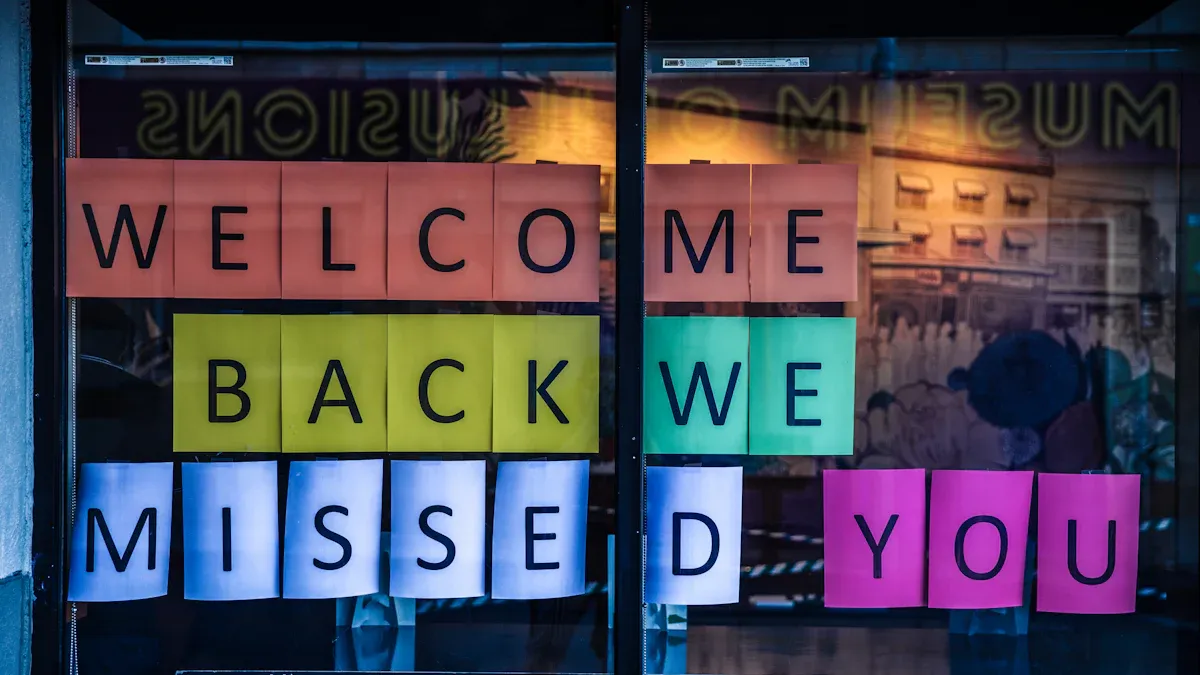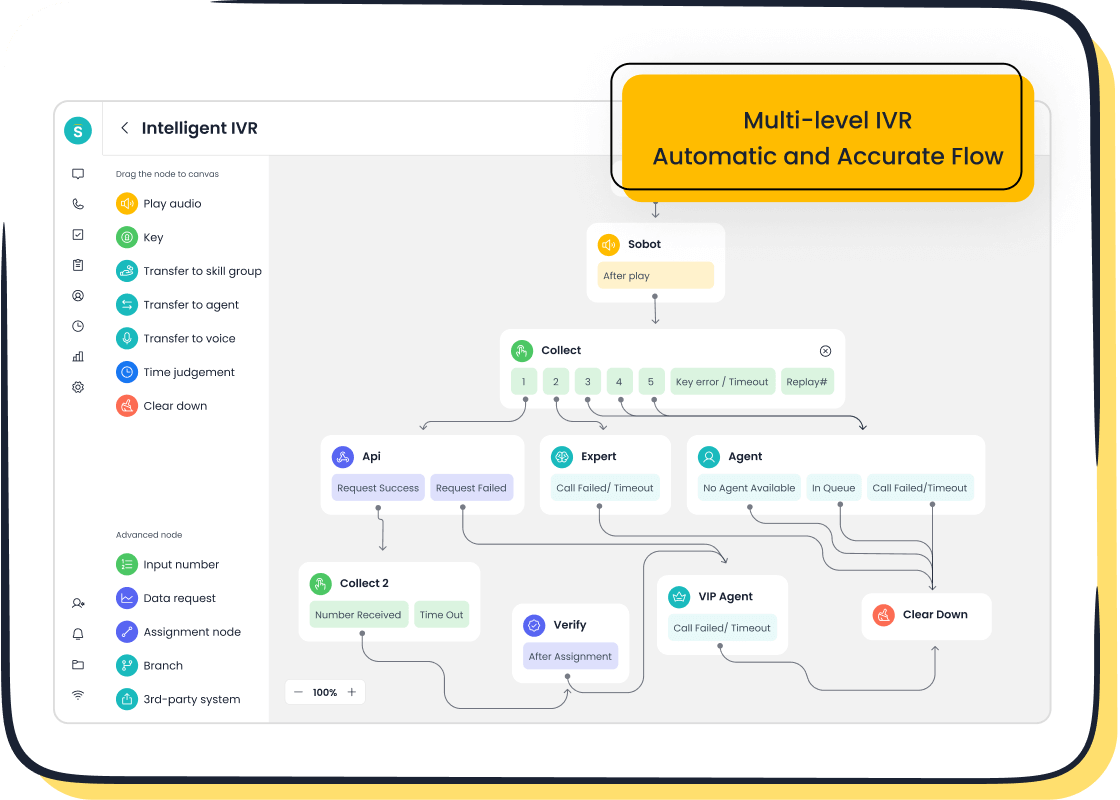Inbound vs Outbound Which Do You Need?

What is inbound call center strategy best for? A business typically chooses an inbound call center for reactive customer support. It selects an outbound call center for proactive growth, like sales. This guide helps businesses confirm the perfect model—inbound, outbound, or hybrid. While many customers prefer chat, phone support remains vital for complex issues, making the right inbound or outbound strategy crucial. Sobot offers an all-in-one Sobot call center, using Sobot AI to power any model for tasks ranging from inbound sales to service.
WHAT IS AN INBOUND CALL CENTER?

So, what is an inbound call center? An inbound call center is a department dedicated to handling incoming customer phone calls. Its primary focus is on providing reactive support and service. This contrasts with outbound centers, which make calls for sales or surveys. The quality of this inbound call center service directly shapes the customer experience and overall brand perception.
PRIMARY GOAL: CUSTOMER SUPPORT
The main goal of an inbound call center is to deliver outstanding customer support. A positive interaction can build strong customer loyalty, while a negative one can drive customers away. Research shows that the experience a company provides is just as important as its products. In fact, 45% of customers have switched brands due to poor customer service. This makes effective inbound support essential for customer retention and satisfaction. A great inbound strategy strengthens brand trust and encourages repeat business, turning satisfaction into long-term loyalty.
KEY FUNCTIONS AND RESPONSIBILITIES
An inbound call center performs many vital functions. Agents handle a wide variety of inbound calls and customer inquiries. These inbound services are crucial for daily operations and maintaining high customer satisfaction.
Key responsibilities include:
- General Customer Support: Answering questions and resolving general concerns about products or services.
- Technical Support: Helping customers troubleshoot technical problems with products.
- Order Management: Processing new orders, tracking shipments, and handling returns.
- Complaint Resolution: Acting as the first point of contact to solve customer issues and handle complaints.
AGENT FOCUS: REACTIVE PROBLEM-SOLVING
Agents in an inbound setting focus on reactive problem-solving. They do not make cold calls; instead, they respond to inbound calls from existing customers seeking help. This role requires a specific set of skills to manage customer expectations and deliver a successful resolution. Achieving first-call resolution is a key measure of success.
Essential Agent Skills for Inbound Success Strong problem-solving skills are a must. Agents also need high emotional intelligence. This includes empathy to understand a customer's frustration and patience to listen without interruption. Using positive language helps turn a difficult situation into a good one, which is vital for customer service.
WHAT IS AN OUTBOUND CALL CENTER?
An outbound call center is a business function where agents make outgoing calls to potential or existing customers. Unlike inbound centers that react to customer needs, outbound call centers proactively initiate contact. This approach is central to driving business growth, generating leads, and expanding market reach. Effective outbound strategies are crucial for companies looking to actively build their customer base.
PRIMARY GOAL: PROACTIVE GROWTH
The primary goal of an outbound call center is proactive business growth. Agents reach out to connect with new audiences and nurture existing relationships. This proactive engagement is key to staying competitive. Outbound call centers help businesses expand into new markets and educate customers about products. This educational approach builds trust and contributes to long-term customer retention.
Successful outbound efforts often include:
- Tailoring messages for different platforms to ensure they resonate.
- Researching a prospect's needs to create a personalized experience.
- Guiding customers through product features to help them make informed decisions.
This strategy boosts lead generation and turns simple interactions into valuable partnerships, fostering strong customer engagement.
KEY FUNCTIONS AND RESPONSIBILITIES
Outbound call centers perform several key functions to support growth. Agents make outbound calls for specific business objectives. These outbound services are designed to guide contacts through the sales funnel. The quality of this call center service directly impacts a company's success.
Key outbound call center services include:
- Telemarketing: Agents sell products or services directly over the phone. They use targeted approaches to encourage purchases and drive revenue.
- Appointment Setting: The goal is to schedule meetings with key decision-makers. This function establishes an initial connection for the sales team.
- Market Research: Organizations use outbound calls to conduct surveys. They gather valuable insights into customer opinions and market trends.
AGENT FOCUS: GOAL-ORIENTED OUTREACH
An outbound agent’s focus is on goal-oriented outreach. They are driven by targets and work to meet or exceed them. This role requires a unique combination of persistence and skill to handle frequent rejection. Their success depends on their ability to make compelling outbound calls and build relationships quickly.
Key Traits for Outbound Agent Success A successful agent is resilient and highly motivated. They possess strong negotiation skills to create beneficial agreements. Excellent communication is also vital for delivering a clear message and understanding customer needs. Adaptability allows them to adjust their approach for different personalities and situations.
COMPARING INBOUND CALL CENTERS AND OUTBOUND CALL CENTERS

Understanding the fundamental differences between inbound and outbound call centers is the first step toward choosing the right model. While both aim to improve business outcomes, their methods, goals, and operational structures are distinct. This comparison breaks down the key distinctions between inbound and outbound call centers.
CALL DIRECTION
The most basic difference between inbound and outbound call centers lies in who initiates the call. This simple distinction defines the entire workflow and agent experience.
- Inbound: Inbound call centers are reactive. The customer initiates contact. They call the business seeking information, help with a product, or resolution for an issue. The call flow is entirely dependent on customer needs, making every interaction unique.
- Outbound: Outbound call centers are proactive. The business initiates contact. Agents make outgoing calls to potential or existing customers. These calls are part of a planned strategy for sales, marketing, or lead generation.
CORE PURPOSE
The core purpose of each call center model directly reflects its call direction. Inbound centers focus on service and retention, while outbound centers concentrate on growth and acquisition.
An inbound call center’s primary purpose is to provide excellent customer support and service. Strong customer service is critical for retention. Research shows that 73% of customers report good service significantly influences their loyalty. Conversely, poor service drives customers away. Approximately 67% of customer churn is preventable if issues are resolved during the first interaction. Inbound teams also handle inbound sales, where customers call to make a purchase.
An outbound call center’s main goal is proactive growth. Agents engage in telemarketing, appointment setting, and market research. This proactive approach shortens sales cycles and gives the sales team more control over the process. By using data to identify opportunities, outbound call centers can turn service follow-ups into new revenue streams and strengthen customer relationships.
AGENT SKILLSET
The different purposes of inbound and outbound call centers demand different agent skillsets. While all agents need strong communication skills, their focus areas vary significantly.
Note: Agent Specializations An inbound agent is a problem-solver, while an outbound agent is a persuader. Each role requires a distinct personality and training focus to meet customer expectations and business goals.
-
Inbound Agent Skills: An inbound agent must excel at reactive problem-solving. Key skills include:
- Empathy and Patience: Understanding a customer's frustration and listening carefully.
- Product Knowledge: Having deep knowledge to answer questions and troubleshoot issues effectively.
- Calm Under Pressure: Maintaining composure during difficult conversations to deliver quality customer service.
-
Outbound Agent Skills: An outbound agent needs to be goal-oriented and resilient. Essential skills include:
- Persuasion: Convincing prospects of a product's value.
- Resilience: Handling rejection without losing motivation.
- Negotiation: Creating agreements that benefit both the customer and the company.
SUCCESS METRICS
Success in inbound and outbound call centers is measured using different Key Performance Indicators (KPIs). These metrics align with the core purpose of each call center service.
For inbound call centers, success is measured by efficiency and customer satisfaction. Key metrics include:
- First Call Resolution (FCR): The percentage of calls where the customer's issue is solved on the first try.
- Average Handle Time (AHT): The average time an agent spends on a call, from start to finish.
- Customer Satisfaction (CSAT): A direct measure of how happy customers are with the service they received.
For outbound call centers, success is measured by sales and productivity. Important metrics include:
- Conversion Rate: The percentage of calls that result in a sale or desired outcome. This is a vital indicator of an outbound campaign's profitability.
- Calls Per Agent: The number of calls an agent makes in a specific period, which tracks productivity.
- First-Call Close Rate: The percentage of deals closed on the initial call, showing agent effectiveness.
Knowing what is inbound call center strategy versus an outbound one helps clarify which metrics matter most for your business.
ESSENTIAL INBOUND CALL CENTER TECHNOLOGY
Choosing the right technology stack is crucial for the efficiency of inbound call centers. The right tools automate workflows, reduce agent workload, and improve the customer experience for all inbound calls. A modern platform like Sobot's Voice/Call Center provides powerful features to manage incoming customer inquiries effectively. Tools such as a drag-n-drop Intelligent IVR and Smart Call Routing are essential for any high-performing inbound operation.

INTERACTIVE VOICE RESPONSE (IVR)
An Interactive Voice Response (IVR) system greets callers with an automated menu. It allows customers to find answers or reach the right department without speaking to an agent. This technology is vital for managing high volumes of inbound calls. It empowers customers with self-service options, which many prefer for simple issues.
- Salesforce research shows that 61% of customers prefer to use self-service for simple customer inquiries.
- A well-designed IVR can increase call satisfaction ratings by 10% to 25%.
Sobot’s Intelligent IVR uses a simple drag-n-drop interface, allowing businesses to build and launch custom call flows in real time. This helps inbound call centers deflect routine questions and free up agents for more complex problems.
AUTOMATIC CALL DISTRIBUTION (ACD)
Automatic Call Distribution (ACD) technology automatically routes inbound calls to the most suitable agent. This system is the engine of an efficient inbound call center. It distributes calls based on pre-set rules, such as agent availability, skills, or customer status. This ensures customer inquiries are handled quickly and by the right person.
ACD software prevents agent burnout by distributing the workload evenly. Sobot’s Smart Call Routing feature ensures that no single agent is overwhelmed, which keeps wait times low and satisfaction high for all inbound interactions.
CRM INTEGRATION
Integrating your inbound call center services with a Customer Relationship Management (CRM) system is a game-changer. This connection gives agents a complete view of the customer's history the moment a call comes in. Agents can see past purchases, previous interactions, and support tickets. This context is critical for providing personalized and efficient support. Companies that integrate their systems see major improvements in customer satisfaction. In fact, a 1% increase in First Call Resolution (FCR) can boost customer satisfaction by up to 5%. This makes CRM integration essential for modern inbound call centers.
ESSENTIAL OUTBOUND CALL CENTER TECHNOLOGY
Effective outbound call centers rely on technology to maximize agent productivity and campaign success. The right tools automate repetitive tasks, streamline workflows, and provide valuable data for making outbound calls. These technologies are the backbone of modern outbound call centers, enabling them to reach more prospects efficiently. For any business focused on growth, investing in these systems is essential for scaling outbound operations.
AUTOMATIC DIALERS
Automatic dialers are a cornerstone for productive outbound call centers. These systems automatically dial numbers from a contact list, saving agents from manual entry. This technology significantly increases the number of outbound calls an agent can make. Different dialers suit different outbound strategies. For example, a predictive dialer makes many outbound calls at once and only connects an agent when a person answers. This is ideal for high-volume campaigns. Progressive and power dialers offer a more controlled pace for outbound calls.
Choosing the Right Dialer The best dialer depends on campaign goals, team size, and compliance needs. The table below compares the most common types used in outbound call centers.
| Dialer Type | Key Feature | Best For |
|---|---|---|
| Predictive | Dials multiple numbers per agent, predicting availability. | High-volume telemarketing and market research. |
| Progressive | Dials one number at a time for an available agent. | Sales teams focused on quality interactions and renewals. |
| Power | Dials the next number as soon as an agent finishes a call. | Follow-up calls where agents need prep time. |
LEAD MANAGEMENT SYSTEMS
A lead management system organizes and tracks potential customers throughout the sales pipeline. This software is vital for outbound call centers because it ensures no lead is forgotten. It allows managers to distribute leads to agents, monitor progress, and analyze which sources generate the best results. For outbound services, this system provides agents with the context they need to personalize their outbound calls. This targeted approach improves conversion rates and makes the entire outbound effort more effective.
BULK OUTBOUND TASK MANAGEMENT
Bulk outbound task management tools help managers create, assign, and monitor large-scale calling campaigns. These platforms automate the process of assigning thousands of outbound calls to agents based on priority or other rules. Sobot’s Voice/Call Center includes a Bulk Outbound Task feature that simplifies this process. It ensures that agents always know which leads to call next, which boosts efficiency. This technology is crucial for outbound call centers aiming for consistent and organized outreach.
THE HYBRID MODEL: SOBOT'S OMNICHANNEL SOLUTION
The debate between inbound vs. outbound is no longer a simple choice. Modern businesses need a flexible approach that handles both reactive support and proactive growth. This is where the hybrid model shines. It blends inbound and outbound call centers into a single, efficient operation. Sobot’s Omnichannel Solution is a prime example of a platform that powers this model. It unifies all customer interactions into one workspace, creating a powerful and seamless call center service.
WHEN TO CHOOSE A HYBRID MODEL
A hybrid model is the ideal choice for businesses that need to be both responsive and proactive. Companies that want to provide excellent customer support while also pursuing sales opportunities will find this model invaluable. It allows a business to manage its resources effectively, adapting to changing call volumes and strategic goals.
Consider a hybrid model if your business needs to:
- Handle inbound support calls and make outbound follow-up calls.
- Turn a service interaction into an opportunity for inbound sales.
- Conduct customer satisfaction surveys after resolving an issue.
- Maximize agent productivity by having them handle both inbound and outbound tasks during different times.
This balanced approach ensures that no opportunity for customer engagement is missed.
BENEFITS OF A UNIFIED PLATFORM
A unified platform is the engine behind a successful hybrid model. It breaks down the walls between inbound and outbound call centers. Sobot’s Omnichannel Solution consolidates voice, chat, email, and ticketing systems into a single view. This creates a seamless customer journey and optimizes resources. A unified approach delivers a better customer experience.
Key benefits of a unified platform include:
- Coherent Narrative: It creates a consistent story for your brand across all channels. Customers receive clear messages, which prevents confusion and frustration.
- Streamlined Journey: The platform guides customers smoothly from awareness to retention. Every interaction feels like part of a well-planned path.
- Maximized Engagement: A hybrid strategy increases interaction opportunities. Inbound methods attract customers, while outbound strategies convert interest into action. This synergy boosts overall customer engagement.
- Personalized Experience: Agents can use insights from inbound interactions to personalize outbound follow-ups. This targeted engagement significantly improves conversion rates.
EMPOWERING AGENTS TO DO MORE
A hybrid model does more than improve the customer experience; it also empowers agents. A varied workload that includes both inbound and outbound tasks can make the job more interesting and reduce burnout. This variety, combined with powerful technology, leads to higher productivity and better employee retention.
Modern tools provide agents with the support they need to succeed in a hybrid role. For example, AI-powered features can offer real-time suggestions during a call. This guidance helps agents resolve issues faster and feel more confident. Sobot’s unified workspace gives agents a complete customer history, enabling them to handle any type of engagement, from an inbound service ticket to an outbound sales call. This level of support is crucial for creating a positive work environment and delivering an exceptional call center service.
A HYBRID SOLUTION IN ACTION: THE OPPO CASE STUDY
Theory is helpful, but seeing a solution in action provides real clarity. OPPO, a leading smart device innovator, demonstrates the power of a hybrid model. The company needed to manage both inbound support and proactive engagement, especially during peak shopping seasons. Their story shows how a unified platform can turn challenges into opportunities for growth.
THE CHALLENGE: MANAGING HIGH VOLUME
OPPO serves over 600 million users worldwide. During major shopping events, the company faced a massive surge in customer inquiries. This high volume overwhelmed human agents, leading to long wait times and customer frustration. OPPO needed a solution that could handle routine questions efficiently while freeing up agents for complex issues. The goal was to improve service speed without sacrificing the quality of customer interactions.
THE SOBOT SOLUTION: HUMAN-MACHINE COOPERATION
OPPO partnered with Sobot to implement a hybrid solution centered on human-machine cooperation. This approach is becoming a standard, as nearly half of all support teams now use AI to streamline workflows. OPPO deployed Sobot’s AI chatbot to handle frequently asked questions, providing instant answers to common inquiries. This allowed human agents to focus on complex problems requiring a personal touch. The integration of Sobot’s chatbot and ticketing system created a seamless workflow, ensuring every customer received a swift and accurate resolution.
THE RESULTS: IMPROVED EFFICIENCY AND SATISFACTION
The results of this partnership were remarkable. By combining AI with a clear strategy, OPPO achieved significant, measurable improvements. This approach is key, as companies that pair AI investment with change management are 2.5 times more likely to see a return.
- The chatbot achieved an impressive 83% resolution rate for automated inquiries.
- The overall positive feedback rate from customers climbed to 94%.
- This boost in customer satisfaction contributed to a 57% increase in the repurchase rate.
OPPO’s success proves that a well-executed hybrid model, powered by a unified platform like Sobot, enhances both efficiency and customer satisfaction.
Choosing the right model is simple. Businesses select inbound call centers for reactive customer support. They use outbound services for proactive sales. A hybrid model balances both needs. The best choice aligns with a company's primary goal. Inbound call centers focus on service, while outbound efforts drive growth. Sobot's all-in-one Voice/Call Center powers both inbound and outbound call centers. Explore Sobot to build the perfect solution for your business.
FAQ
### Which call center model is better for a small business?
The best model depends on the business goal. A small business focused on customer service should choose an inbound model. A business aiming for rapid growth through lead generation should select an outbound model. Many small businesses benefit from a hybrid approach to balance both needs effectively.
### Can one agent handle both inbound and outbound calls?
Yes, this is common in a hybrid model. Agents can handle both call types. This approach maximizes productivity. It allows agents to answer customer support questions and also make proactive sales or follow-up calls during slower periods. A unified platform like Sobot makes this transition seamless.
### How does AI improve call center performance?
AI enhances both inbound and outbound operations.
- For inbound: AI-powered IVRs and chatbots handle routine questions. This frees up human agents for complex issues.
- For outbound: AI can help analyze data to identify the best leads to call. This improves agent efficiency and conversion rates.
### Is an inbound or outbound call center more expensive?
Costs vary based on technology, staffing, and call volume. Outbound centers can have higher initial costs due to sales commissions and dialer technology. Inbound centers may have costs tied to support software and training. A hybrid model offers a cost-effective balance by optimizing agent time.
See Also
Demystifying Live Chat Outsourcing: A Comprehensive Look at Associated Costs
Comparing the Best Interactive Voice Response (IVR) Software Solutions
Your Essential Guide to Omnichannel Call Center Software Solutions
Genesis Call Center Versus Genesys: A Detailed Comparison to Decide
Reviewing the Leading Contact Center Solutions: Our 2024 Top Picks
